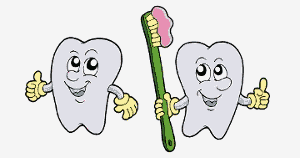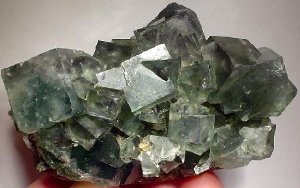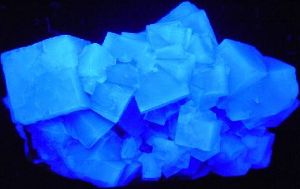The chemical element fluorine is classed as a halogen and a nonmetal . It was discovered in 1813 by Humphrey Davy.

Data Zone
| Classification: | Fluorine is a halogen and a nonmetal |
| Color: | pale yellow |
| Atomic weight: | 18.998403 |
| State: | gas |
| Melting point: | -219.6 oC, 53.6 K |
| Boiling point: | -188.1 oC, 85.1 K |
| Electrons: | 9 |
| Protons: | 9 |
| Neutrons in most abundant isotope: | 10 |
| Electron shells: | 2,7 |
| Electron configuration: | 1s2 2s2 2p5 |
| Density @ 20oC: | 0.001696 g/cm3 |
Reactions, Compounds, Radii, Conductivities
| Atomic volume: | 17.1 cm3/mol |
| Structure: | cubic crystals in solid phase |
| Hardness: | – |
| Specific heat capacity | 0.82 J g-1 K-1 |
| Heat of fusion | 0.510 kJ mol-1 of F2 |
| Heat of atomization | 79 kJ mol-1 |
| Heat of vaporization | 6.62 kJ mol-1 of F2 |
| 1st ionization energy | 1681 kJ mol-1 |
| 2nd ionization energy | 3374.1 kJ mol-1 |
| 3rd ionization energy | 6050.3 kJ mol-1 |
| Electron affinity | 328 kJ mol-1 |
| Minimum oxidation number | -1 |
| Min. common oxidation no. | -1 |
| Maximum oxidation number | 0 |
| Max. common oxidation no. | 0 |
| Electronegativity (Pauling Scale) | 3.98 |
| Polarizability volume | 0.634 Å3 |
| Reaction with air | none |
| Reaction with 3 M HNO3 | ⇒ NO3F |
| Reaction with 6 M HCl | vigorous, ⇒ HF, OF2, ClF3 |
| Reaction with 6 M NaOH | m vigorous, ⇒ O2, NaF |
| Oxide(s) | OF2 |
| Hydride(s) | HF (fluoric acid) |
| Chloride(s) | ClF, ClF3, ClF5 |
| Atomic radius | 50 pm |
| Ionic radius (1+ ion) | – |
| Ionic radius (2+ ion) | – |
| Ionic radius (3+ ion) | – |
| Ionic radius (1- ion) | 119 pm |
| Ionic radius (2- ion) | – |
| Ionic radius (3- ion) | – |
| Thermal conductivity | 0.0277 W m-1 K-1 |
| Electrical conductivity | – |
| Freezing/Melting point: | -219.6 oC, 53.6 K |

The fluoride ion, from the element fluorine, inhibits tooth decay.

Fluorite (originally called fluorspar) crystals in daylight.

The same fluorite crystals fluorescing in darkness after exposure to light. The phenomenon of fluorescence was given its name because it was first observed in fluorite. Actually, the glow does not come from fluorine but from small amounts of europium in the fluorite. Photo Credits: Rob Lavinsky, iRocks.com
Discovery of Fluorine
In 1530, German mineralogist Georgius Agricola described the use of the mineral fluorspar in metal refining. Fluorspar (which we now know is mainly calcium fluoride) was very useful because it combined with the unwanted parts of metal ores, allowing the pure metal to flow and be collected.
The element fluorine had not yet been discovered and the ‘fluor’ in fluorspar came from the Latin word ‘fluere,’ meaning ‘to flow,’ because this is what it allowed metals to do. The element name fluorine ultimately came from the ‘fluor’ in fluorspar.
Several chemists carried out experiments on fluorspar in the early 1800s including Gay Lussac, Louis Jacques Thenard, Humphry Davy, Carl Wilhelm Scheele and Joseph Priestley.(1)
Often they produced what they called fluoric acid – now named hydrofluoric acid – a highly reactive and potentially deadly acid. Even small splashes of this acid on skin can be fatal.(2)
Several early attempts to isolate fluorine led to blindings and fatalities. English chemist Humphrey Davy wrote: “[fluoric acid] is a very active substance, and must be examined with great caution.(1)
In 1809, French scientist Andre-Marie Ampere proposed that fluoric acid was a compound of hydrogen with a new element. He exchanged letters with Humphry Davy, and in 1813 Davy announced the discovery of the new element fluorine, giving it the name suggested to him by Ampere.
Davy wrote: “… it appears reasonable to conclude that there exists in the fluoric compounds a peculiar substance, possessed of strong attractions for metallic bodies and hydrogen… it may be denominated fluorine, a name suggested to me by M. Ampere.” (1)
Fluorine was finally isolated in 1886, by French chemist Henri Moissan – whose own work was interrupted four times by serious poisoning caused by the element he was pursuing.(3)
Moissan isolated fluorine by electrolysis of dry potassium hydrogen fluoride and anhydrous hydrofluoric acid.
To limit corrosion he carried out his work in a platinum container and cooled the electrolytic solution in it to -23 oF (-31 oC.) The stoppers were made out of fluorite (a more modern name for our old friend fluorspar, which we began this section with). Fluorine was produced at the positive electrode.(3)
Henri Moissan received the 1906 Nobel Prize in Chemistry for his achievement.
Interesting Facts about Fluorine
- Henri Moissan, who first isolated fluorine, also produced the world’s first artificial diamonds by applying huge pressures to charcoal.
- Fluorine is the most chemically reactive element. It reacts, often very vigorously, with all of the other elements except oxygen, helium, neon and krypton.
- Fluorine is the most electronegative element. This means that in molecules fluorine attracts electrons more powerfully than any other element can.
- Hydrofluoric acid, HF, dissolves glass. Its fluoride ions have a high affinity for calcium and can cause death by interfering with the body’s blood calcium metabolism when absorbed through the skin.

Appearance and Characteristics
Harmful effects:
Fluorine is highly toxic and corrosive.
Characteristics:
Fluorine is the most reactive and the most electronegative of all the elements.
Fluorine is a pale yellow, diatomic, highly corrosive, flammable gas, with a pungent odor. It is the lightest halogen.
It reacts violently with water to produce oxygen and the extremely corrosive hydrofluoric acid.
Uses of Fluorine
Fluorine and its compounds – mostly uranium hexafluoride – are used in processing nuclear fuel.
Fluorochemicals, including many high-temperature plastics such as Teflon, are also made using fluorine.
Compounds of fluorine, including sodium fluoride, are used in toothpaste and in drinking water to prevent dental cavities.
Hydrofluoric acid can dissolve glass and is used to etch the glass in light bulbs and in other products.
Chlorofluorocarbons (CFCs) were used in as refrigerants in air conditioning units and freezers but they have now been banned because they contribute to ozone depletion.
Abundance and Isotopes
Abundance earth’s crust: 585 parts per million by weight, 104 part per million by moles
Abundance solar system: 500 parts per billion by weight, 30 parts per billion by moles
Cost, pure: $190 per 100g
Cost, bulk: $ per 100g
Source: In nature, fluorine occurs mainly in the minerals fluorspar (CaF2) and cryolite (Na3AlF6). Commercially, production of fluorine involves the electrolysis of a mixture of molten potassium fluoride and hydrofluoric acid. Fluorine gas forms at the anode, and hydrogen gas at the cathode.
Isotopes: Fluorine has 11 isotopes whose half-lives are known, with mass numbers 15 to 25. Naturally occurring fluorine consists of its one stable isotope, 19F.

References
- H. Davy, Some Experiments and Observations on the Substances Produced in Different Chemical Processes on Fluor Spar., Philosophical Transactions of the Royal Society of London, Vol 103, (1813) p263-279.
- Facts About Hydrogen Fluoride. Centers for Disease Control and Prevention (CDC), National Institute for Occupational Safety and Health (NIOSH).
- Elvira Weeks, The Discovery of the Elements., J. Chem. Ed., Vol 9 No 11, (1933) p1915 – 1939.
Cite this Page
For online linking, please copy and paste one of the following:
<a href="https://www.chemicool.com/elements/fluorine.html">Fluorine</a>
or
<a href="https://www.chemicool.com/elements/fluorine.html">Fluorine Element Facts</a>
To cite this page in an academic document, please use the following MLA compliant citation:
"Fluorine." Chemicool Periodic Table. Chemicool.com. 16 Oct. 2012. Web. <https://www.chemicool.com/elements/fluorine.html>.